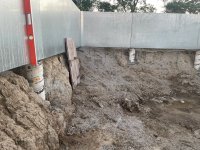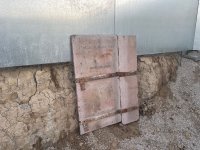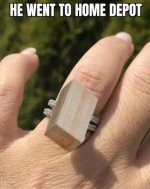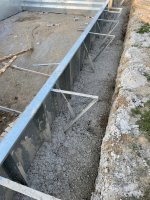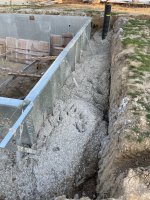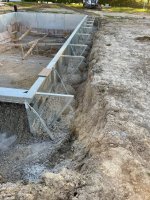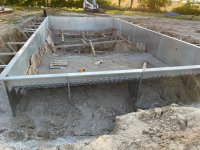@jimmythegreek Sorry for not typing clearly, it isn't my strength for sure. You are correct, the hopper was dug too wide. I have a little bit of flexibility to slide the pool over but on that end, I am kind of boxed in by an inground power line. What am I looking at if I wanted to repair the shelf part? In my mind, I thought it would make sense to build a long concrete form out of plywood or something and pour a mini shelf to correct the actual shelf. The yellow lines in my elementary level of drawing. I could go extra deep and add fiber on the collar for support? Or does this expose a safety concern in your mind? Thanks again for your time!Not following you. Overdug means too deep. Do you mean too wide? If that's the case the easiest thing is to slide the pool over amd make a new back wall ledge. Then use stone on the slope to fix. Otherwise you got a mess on your hands. Excavators aren't pool diggers. Its an art
Water is being trucked in! Intellicenter question though
- Thread starter Justin9314
- Start date
You are using an out of date browser. It may not display this or other websites correctly.
You should upgrade or use an alternative browser.
You should upgrade or use an alternative browser.
He dug the pool wrong. When you dig a pool you dig the whole shallow shelf first, then before you back out of pool you dog the hopper after marking it out. Then you come out of the hole amd dig the remaining shallow end from above so you dont make a ramp from pool. This happens alot.
You can use piers to support the walls and then form the front bottom to it doesnt leak out when you do the hopper. You can make a shelf too with forms. The goal is to get the collar poured to hold it in place, then it doeant matter as much what's under it. Gotta watch the rain, slide outs are a nightmare. We hustle hard after digging to get walls up and collar poured, after that you can slow the build down but gotta rush that part
You can use piers to support the walls and then form the front bottom to it doesnt leak out when you do the hopper. You can make a shelf too with forms. The goal is to get the collar poured to hold it in place, then it doeant matter as much what's under it. Gotta watch the rain, slide outs are a nightmare. We hustle hard after digging to get walls up and collar poured, after that you can slow the build down but gotta rush that part
I really appreciate all of the advice. I have dug through this site and did find a post that used piers. Makes sense. I have been tarping it off every time it calls for rain and has the well already plumbed. However, it's supposed to be raining between now and Sunday. Good to know I need to keep pushing through it though.He dug the pool wrong. When you dig a pool you dig the whole shallow shelf first, then before you back out of pool you dog the hopper after marking it out. Then you come out of the hole amd dig the remaining shallow end from above so you dont make a ramp from pool. This happens alot.
You can use piers to support the walls and then form the front bottom to it doesnt leak out when you do the hopper. You can make a shelf too with forms. The goal is to get the collar poured to hold it in place, then it doeant matter as much what's under it. Gotta watch the rain, slide outs are a nightmare. We hustle hard after digging to get walls up and collar poured, after that you can slow the build down but gotta rush that part
Sean ATX
Bronze Supporter
Excuse the intrusion but this part caught my eye. How deep would you recommend the hopper concrete be? Does that eventually get smoothed over with the pool base mix too?I personally overdig the hopper floor amd pour concrete from the collar for that section of floor. Makes a spot to mix the verm and hard edges to float to. Helps go have a guy or two in the hopper shaping it with picks and shovels.
Good luck with the build, @Justin9314. I'm watching this with much interest.
I carefully string out the hopper floor using tape measure amd a laser and make a form exact size about 5" thick. I usually dig out about 10" and throw stone under for a good base. I pour that when I do the collar. That becomes my guide and I bring vermiculite to that not covering it over. I mix my base on that spot it's my home base for the inside pool work too. I add stone to the floor to fine tune my sub base for the vermiculite, amd if needed dry mixed concrete to fill any angle wall voids or slide outside prior to doing the verm
Walls are in! Got the piers installed to correct the over dig. So thankful for this site and @jimmythegreek because I would have not thought of that solution or sure! I will call for an inspection tomorrow and hope to get footers poured by next weekend.
Kind of a strange question, however I still don't have my 4 LED lights. I did order the CMP brilliant wonders lights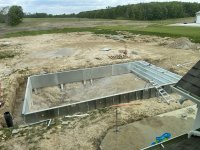 . I would hate for the pool to come to a standstill just because of a secondary parts delay. Can I still plumb the electrical conduct and move on? If the lights do not come in by the time the liner would be going in, what options would I have? Do they sell blank covers for these 1.5" holes or could I leave the open (Water obviously would go in, but I don't think it would have enough pressure to push it naturally up to the pool pad?) My inexperienced thought was to leave them open, wait til it is time to winterize and put them down when I have to drain the pool anyways? How far do you normally have to drain a pool with an auto cover installed?
. I would hate for the pool to come to a standstill just because of a secondary parts delay. Can I still plumb the electrical conduct and move on? If the lights do not come in by the time the liner would be going in, what options would I have? Do they sell blank covers for these 1.5" holes or could I leave the open (Water obviously would go in, but I don't think it would have enough pressure to push it naturally up to the pool pad?) My inexperienced thought was to leave them open, wait til it is time to winterize and put them down when I have to drain the pool anyways? How far do you normally have to drain a pool with an auto cover installed?
Kind of a strange question, however I still don't have my 4 LED lights. I did order the CMP brilliant wonders lights
 . I would hate for the pool to come to a standstill just because of a secondary parts delay. Can I still plumb the electrical conduct and move on? If the lights do not come in by the time the liner would be going in, what options would I have? Do they sell blank covers for these 1.5" holes or could I leave the open (Water obviously would go in, but I don't think it would have enough pressure to push it naturally up to the pool pad?) My inexperienced thought was to leave them open, wait til it is time to winterize and put them down when I have to drain the pool anyways? How far do you normally have to drain a pool with an auto cover installed?
. I would hate for the pool to come to a standstill just because of a secondary parts delay. Can I still plumb the electrical conduct and move on? If the lights do not come in by the time the liner would be going in, what options would I have? Do they sell blank covers for these 1.5" holes or could I leave the open (Water obviously would go in, but I don't think it would have enough pressure to push it naturally up to the pool pad?) My inexperienced thought was to leave them open, wait til it is time to winterize and put them down when I have to drain the pool anyways? How far do you normally have to drain a pool with an auto cover installed?
Last edited:
No issue on lights. Install the fittings and plumb them back to your Jboxes. When you install the liner install the faceplates but dont cut the liner out til lights arrive. You can fill and use pool amd just drain down for the actual install. Water wont push the liner thru the gasket holds it tight
Good job on the walls. Make sure to form and brace them VERY well go overboard. Wet concrete is heavy it's a pain to fix leakage under the wall panels.. it's ok to leak down low under the verm but the top needs to be nice. You can svrew into the wall panels, foam covers it all just be sure nothing sharp is left when removing any screws
Good job on the walls. Make sure to form and brace them VERY well go overboard. Wet concrete is heavy it's a pain to fix leakage under the wall panels.. it's ok to leak down low under the verm but the top needs to be nice. You can svrew into the wall panels, foam covers it all just be sure nothing sharp is left when removing any screws
Concrete is scheduled for tomorrow for footers! Based on reading through this form, my forms do not need to be straight up and down right? Since I do not have any real slopes currently? BTW, I literally cried at HD when I bought the 2 x 4s and OSB board. Luckily I was able to source some concrete forms but plan to brace them. Is it best to use the ground as the other end of the brace or use a stake and tie it into the stake? @jimmythegreek
Attachments
Now that is great! I mean $15 for a single 2 x4...
Question for the group... For my drainage around the pool, do I use the PVC with holes in it, the 4" black corrugated piping or do you recommend something else?
Sdr35 that is perforated is what I use. Holes facing down. Drain to daylight of you can or a sump pit. Clean stone around the pipe amd wrap stone amd pipe with filter fabric
Few questions for my next phases if you all don't mind 
When I bond the pool, I know I need a minimum of 4 touches (plan to do six). The question here is should this be an endless loop or is it okay to tie different sections together with a post of some type?
I ordered 4 CMP brilliant wonder LED lights. For the conduit, do I need to do home runs for each one? The cord length is 100' for each one, so I was hoping to avoid a junction box around the pool and have them tie together at the pool pad. Through my searching, I couldn't find a y type adapter for the conduit. My thoughts were to run 2" main conduit and branch off that at each light?
There is a second small hole in my skimmer (1.5") which I believe is for a vacuum? Do I just plug this or is there a different purpose for it?
I really appreciate the help everyone! I can see the finish line getting closer My goal is to still have this done by mid-July before our baby is due, so the clock is ticking for me!
My goal is to still have this done by mid-July before our baby is due, so the clock is ticking for me!
When I bond the pool, I know I need a minimum of 4 touches (plan to do six). The question here is should this be an endless loop or is it okay to tie different sections together with a post of some type?
I ordered 4 CMP brilliant wonder LED lights. For the conduit, do I need to do home runs for each one? The cord length is 100' for each one, so I was hoping to avoid a junction box around the pool and have them tie together at the pool pad. Through my searching, I couldn't find a y type adapter for the conduit. My thoughts were to run 2" main conduit and branch off that at each light?
There is a second small hole in my skimmer (1.5") which I believe is for a vacuum? Do I just plug this or is there a different purpose for it?
I really appreciate the help everyone! I can see the finish line getting closer
you want a "continuous loop" but you can use a split bolt connector that is rated for direct burial to connect two lengths of wire together. Also my inspector wanted the ground lug of my sub-panel to be in the "loop" so I have the loop around the pool tie together with a split bolt connector then i have two wires running back to the equipment pad one of the runs connects to all the equipment then runs up to the sub panel ground/bond lug before connecting back to the other run of wire completing the "loop."
Last edited:
- May 7, 2014
- 429
- Pool Size
- 29980
- Surface
- Vinyl
- Chlorine
- Salt Water Generator
- SWG Type
- Hayward Aqua Rite (T-15)
Few questions for my next phases if you all don't mind
When I bond the pool, I know I need a minimum of 4 touches (plan to do six). The question here is should this be an endless loop or is it okay to tie different sections together with a post of some type?
I ordered 4 CMP brilliant wonder LED lights. For the conduit, do I need to do home runs for each one? The cord length is 100' for each one, so I was hoping to avoid a junction box around the pool and have them tie together at the pool pad. Through my searching, I couldn't find a y type adapter for the conduit. My thoughts were to run 2" main conduit and branch off that at each light?
There is a second small hole in my skimmer (1.5") which I believe is for a vacuum? Do I just plug this or is there a different purpose for it?
I really appreciate the help everyone! I can see the finish line getting closerMy goal is to still have this done by mid-July before our baby is due, so the clock is ticking for me!
jamjam got the bonding answered. To elaborate on what I did, I attached a bonding lug to every piece of coping around the pool (overkill). I had a solid run of copper that went all the way around and back to the pump pad. It curved in and attached to each lug on the pieces of coping and was also tied my 2 light niches and my handrail and ladder with shorter pieced clamped in. All the lugs and splices were rated for direct burial. I bought a whole spool of the copper and had plenty..so I made a 2nd loop about 3' further out than the 1st loop and tied the two together. I fastened both runs to my rebar for the deck. It is way more than I needed...but I sleep good. The guy that I hired to pour my pool deck (he builds pools for a living) said that the bonding was the best he had ever seen.
For your lights...you will want a dedicated run of conduit from the light to the pad or a junction box. It would not be good to have Y's or T's in your buried conduit, it would make a nightmare for future wire pulling. If 100' is long enough to go from each light to your pump pad...then that is what I would do. If not...find a spot that you can run all 4 to and put a junction box or in your case maybe 2 junction boxes then a home run or two to your pad. You can't splice the wires inside the conduit...only in a junction box that is like 12" above the waterline. I had to do this, I had 2 lights with 50' cords. I went in the middle and added this box just outside my concrete deck.
https://www.amazon.com/gp/product/B003WOL53C/ref=ppx_yo_dt_b_search_asin_title?ie=UTF8&psc=1
I had one home run from the pump pad to the this box and then the other 2 were to the lights. I hated it..but now that it's all done, you don't even know that it's there. This junction box also has a lug to bond...so I have it hooked to my bonding grid.
My skimmers had 2 threaded holes in the bottom. Some people hook main drains to one hole of the skimmer and the other goes to the pump. You can also daisy chain multiple skimmers together. I would not recommend doing either of those things. I would run each skimmer all the way to the pad as well as the main drains if you are putting them in. So in that case I would put a threaded plug in the bottom and in the top of that extra hole where you just have the one hole with a line that goes to your pad.
Cap off the 2nd hole and run home runs back to the pad for each skimmer. It's better if you can home run everything on the return side too. For the lights you want seperate runs. Alot of people reduce behind the pool 2-3ft to 1" conduit to save a few bucks. Remember that all this conduit must be waterproof and care taken when glueing/transitioning with fittings. I pressure test the lines now after seeing some disasters when doing nicheless lights. Some inspectors will bust chops amd allow only 2 fittings in the transition, ask the electrical inspector if he has any rules you need to adhere to. Some also treat any electrical conduit whether low voltage or not the same, amd limit max bends to 360 degrees ie 4 90 fittings max on each run
I am sure I am overthinking this, but nonetheless... I am in the process of bonding my pool. My pool pad is about 100' away. I plan to do a continuous loop, but for the 100' back to the pool pad, should I put the copper into the conduit? My mind says no since everywhere else it is in contact with the ground but figured doing it right the first time always makes sense. Any suggestions would be great!
Thanks
Thanks
- May 7, 2014
- 429
- Pool Size
- 29980
- Surface
- Vinyl
- Chlorine
- Salt Water Generator
- SWG Type
- Hayward Aqua Rite (T-15)
Not needed, just put it in the ditch with the plumbing/electrical running from the pool to the pad.I am sure I am overthinking this, but nonetheless... I am in the process of bonding my pool. My pool pad is about 100' away. I plan to do a continuous loop, but for the 100' back to the pool pad, should I put the copper into the conduit? My mind says no since everywhere else it is in contact with the ground but figured doing it right the first time always makes sense. Any suggestions would be great!
Thanks
Thread Status
Hello , This thread has been inactive for over 60 days. New postings here are unlikely to be seen or responded to by other members. For better visibility, consider Starting A New Thread.



